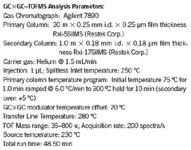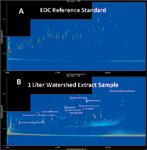A Broad Spectrum GC?GC–TOFMS Analysis for Endocrine Disruptor Compounds in a Midwestern U.S. Watershed
Water samples from six urban and rural locations were extracted and analyzed by GC?GC–TOFMS. GC?GC–TOFMS provided an analysis approach for the detection of known EDCs as well as other non-targeted persistent pollutants.
Water samples from six urban and rural locations were extracted and analyzed by GC×GC–TOFMS. GC×GC–TOFMS provided an analysis approach for the detection of known EDCs as well as other non-targeted persistent pollutants.
There is increasing worldwide concern among scientists and the public over long-term environmental exposure to endocrine disruptor compounds (EDCs). Serious health effects to humans and global ecological systems have prompted the international community to organize expert groups and establish research in evaluation of EDC-related issues. This application note presents a practical, robust, reliable, and sensitive broad range analysis method for the trace-level detection of EDCs in impacted waterways using solid phase extraction followed by GC×GC–TOFMS.
Experimental Conditions
A solid-phase extraction (SPE) procedure was developed using 1-L aliquots of HPLC water spiked with a prepared 108-component EDC reference standard. The GC×GC–TOFMS method was developed using the reference standard. Thirteen 1-L extractions were conducted from six locations along a Midwestern U.S. watershed. Extractions were conducted using Supel-Select HLB-SPE cartridges (Supelco Analytical, Sigma-Aldrich). Duplicate sample injections by GC×GC–TOFMS analysis were carried out immediately after sample preparation. Data processing was performed with NIST and Wiley library mass spectral search and a "Reference" method developed within LECO's ChromaTOF® software.

Results
Duplicate GC×GC–TOFMS analyses of 13 1-L aqueous extractions resulted in the detection of 102 chemicals that would be classified as EDCs. Chemicals found included pharmaceuticals, pesticides, polymer additives, coatings materials, personal care products, flame retardants, industrial by-products, and miscellaneous pollutants. Furthermore, results show that 81% of the 102 detected chemicals were found in five different water samples.

Figure 1: In the figure above (A) shows the GCÃGC contour plot of the 108 component reference standard while (B) shows a 1-L extracted sample GCÃGCâTOFMS analysis with selected target and untargeted analytes from the EDC study.
Conclusions
GC×GC–TOFMS was utilized in this application to detect 102 endocrine disruptors, and other pollutants in samples obtained from a Midwestern U.S. watershed. GC×GC increases peak capacity and facilitates enhanced detection while TOFMS allows fast non-targeted data acquisition necessary to successfully characterize trace levels of EDCs and other emerging contaminants.
LECO Corporation
3000 Lakeview Avenue, St. Joseph, MI 49085
tel. (269) 985-5496, fax (269) 982-8977
Website: www.leco.com

Separation of Ultra-Short and Long Chain PFAS Compounds Using a Positive Charge Surface Column
December 11th 2024A separation of ultra-short and long chain PFAS (C1-C18) is performed on a HALO®PCS Phenyl-Hexyl column along with a HALO®PFAS Delay column which demonstrates excellent retention for both hydrophilic and hydrophobic analytes.

.png&w=3840&q=75)

.png&w=3840&q=75)



.png&w=3840&q=75)



.png&w=3840&q=75)














